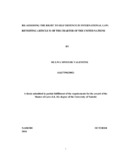| dc.description.abstract | The United Nations Charter at Article 2(4) specifically calls on all members of the United Nations to refrain in their international relations from the threat or use of force. Article 51 of the Charter, however, permits individual or collective use of force in exercise of the right to self-defence and only so in response to an armed attack. All other resort to use of force is subject to authorisation from and management by the Security Council. The Council determines whether measures for the use of force are appropriate in each circumstance as it is charged with the primary responsibility for the maintenance of international peace and security.
However, what appears to be a clear delineation on when an individual State or group of States may resort to the use of force in international law has been blurred by state practice. Actual state practice, exhibited by the States’ interpretation of Article 51 of the Charter and the use of force in purported exercise of the right to self-defence, indicates that States are operating outside the provisions of the Charter. The use of force in this regard is therefore, illegal. It is, however, appreciated that the modern State has to contend with threats that were not contemplated by the Charter in 1945. These include technological advancements in modern warfare and communication, as well as the increase of States interests beyond their territorial boundaries and the significant danger posed by attacks initiated by non-state actors. Some of the actions taken by the States have in retrospect shown to have been justified and necessary at the time for the preservation of State security. Thus, although the action taken may itself have been illegal to the extent that it offends the express provisions
xxiii
of the Charter, it was nevertheless necessary and justified and therefore, legitimate. Consequently, States now agitate for a wider scope of the right to self-defence; beyond the provisions of Article 51 of the Charter. This agitation is manifest in the arguments set forth by States in justifying their resort to the use of force. This paper addresses the issue whether or not there is need to re-articulate the provisions of Article 51 with a view of taking into account contemporary state practice in the purported exercise of the right to self-defence.
Chapter one of the paper introduces the problem. It states the hypotheses underlying the research, sets forth the research questions sought to be answered and identifies the theoretical framework from which the paper stems. It also outlines in summary the views of different scholars on the right to self-defence in international law. Chapter two is the theoretical chapter. It analyses the evolution and scope of the right to self-defence in international law and examines in detail the said right under customary international law and treaty law. Chapter three examines the role of the Security Council in regulating the right to self-defence in international law. Chapter four highlights state practice with regard to the interpretation of Article 51 of the Charter and the use of force by States in international law. It seeks to illustrate whether action taken by the State in each case is both legal and legitimate. Chapter five makes a conclusion of the study in light of the statement of the problem and the hypotheses. It ends with a recommendation to review Article 51 of the Charter with a view of taking cognisance of emerging threats faced by States in contemporary international law | en_US |



